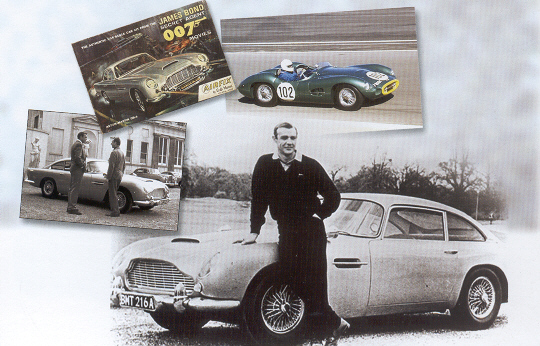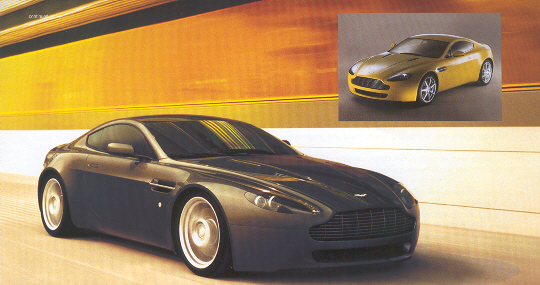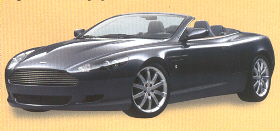|
It
is a partnership that has endured more than 40 long
years and looks destined to be inextricably linked for
decades to come. And it is an association that few can
fail to be mesmerized or inspired by.
Throughout the
years, death-defying stunts, seductive spies, driving on
two wheels, crashing barricades and top-secret documents
have been but the norm in 007 movies and the connecting
thread through all these explosive escapades has been
the Bond car – more rightly identified as an Aston
Martin, and one of the most popular, considering that it
featured in no less than five movies.
Indeed, it appears
that for Bond – the suave immaculate British gentleman
and the consummate connoisseur - Aston Martin was and is
the only choice. This legendary partnership that first
began in 1964 with the movie, Goldfinger,
continues to this day and is an integral part of the
scheduled November 2006 release, Casino Royale.
So what is it about
the Aston Martin that ceaselessly enthralls not just the
world’s most famous spy but also millions of car lovers
across the world?
Perhaps it is the
passion with which the car is made, a passion shared by
its enthusiastic owners who believed that a sports car
should have a distinctive and individual character. More
than 90 years ago, the firm’s co-founder Lionel Martin,
a motor racing enthusiast, set the scene when he laid
out his vision for “A quality car of good performance
and appearance: a car for the discerning owner driver
with fast touring in mind, designed, developed,
engineered and built as an individual.”
Over the years many
different owners have shaped the company and many subtle
or distinctive changes too have come about in its
structure and framework. Yet, the passion for power and
performance remains steadfast and the goals set by its
founders as early as 1914 are still very relevant today.
With its penchant
for producing fine, civilized, high performance sports
cars, designed and produced by skilled craftsmen, Aston
Martin makes cars that bring to life the freedom and
enjoyment of the open road thereby creating a special
place in the market and in the hearts of owners for
classic sports cars which conform to this ideal. It is
this enviable reputation and adherence for quality,
performance, style and engineering that elevates an
Aston Martin to the very pinnacle of the automotive
world even nine decades on.
It was
in 1913 that Lionel Martin turned his passion into a
business when he joined forces with Robert Bamford in a
small West London workshop. At the time, Martin
regularly competed and won in climbs at Aston Hill and
soon after Bamford’s early retirement, the name Aston
was added on, thus laying the beginnings of the Aston
Martin legend.
In March 1915, the
very first Aston Martin car was registered and very
soon, the marque rapidly established its racing
credentials. The high point came in 1922 when an Aston
Martin known as ‘Bunny’ broke 10 world records at
Brooklands, clocking an average speed of 76.04mph during
a sixteen and a half hour run.
Lionel Martin left
the company in 1925 after which ownership changed hands
several times until in post-war 1947 when tractor tycoon
David Brown bought over the firm and the DB era dawned.
Brown had a passion for high performance cars and wanted
his new marque to win worldwide recognition.
Meanwhile, he also
bought luxury carmaker Lagonda and coachbuilder Tickford,
the combined resources of which brought new dynamism and
great achievement on and off the track. The DB series,
all powered by a straight six-engine, was first
introduced in 1950 and its reputation as the finest
British car soared thanks to its fine balance between
performance and luxury, and also because of its good
craftsmanship and tasteful styling.
In 1957 came the
DB Mk III, one of the first production cars to
feature disc brakes - a direct development of the
company’s racing experience. During the late 1950s, four
Works DBR1s won six World Championship races and set
five lap records. The DB4, equipped with a 3.7 litre
aluminium alloy engine and which represented a major
leap forward in design, was introduced in 1958. However,
the rapidly rising cost of racing began to take its toll
and by the end of 1963 it was decided to withdraw from
motorsport and concentrate on refining the production
cars.
In retrospect, this
turned out to be a bold but enlightened decision since
it heralded a new era for Aston Martin as the company’s
production and reputation stepped up a gear. In October
1963, the legendary 4-litre DB5 was introduced.
Production was also doubled to meet world demand and
there was no doubt that the car owed some of its global
esteem to a starring role in the James Bond films
Goldfinger and Thunderball - where its
‘factory- fitted options’ included machine guns, a
passenger ejector seat, hydraulic over-rider rams and
equipment for projecting oil, nails and smoke.
A decade later, in
1972, Aston Martin Lagonda stepped into another new era
where ownership was to change several times over the
course of the next decade until in 1987 when Ford
purchased 75 per cent of the company’s shares. This was
also the year that the company teamed up with James Bond
in The Living Daylights. October 1988 saw the
unveiling of the Virage, designed to take the firm into
the 21st century. Its 155mph, two-door 2+2 replaced the
V8, which had been in production for 20 years.
With Ford’s
involvement there was investment in design, production
and the sourcing of components and materials. 1992 saw
an extension of the Virage model range - with a 6.3
litre engine conversion, and the debut of the first
production model of the Virage Volante Convertible. In
1993, Aston Martin announced the return of a DB model
for the first time in more than 20 years. Unveiled at
the Geneva Motor Show that year, the DB7 was named ‘Car
of the Show’.
Having invested £65
million in the company for the design, development and
provision of manufacturing facilities for the DB7, Ford
took complete ownership of Aston Martin Lagonda that
same year and in 1995, a record of sorts was established
when more than 700 new cars were produced and delivered
in a single year for the first time in the company’s
history.

The world debut of
the DB7 Volante at the Detroit and Los Angeles
International Auto Shows in 1996 signalled the return of
Aston Martin to North America. Meanwhile the DB7 rapidly
developed into the most successful car ever built by
Aston Martin Lagonda with the 1,000th DB7 being
completed in October 1996 and the 2,000th in July 1998.
In February 2001
the V12 Vanquish, the most sophisticated and
technologically advanced new model ever to be designed,
developed and built by Aston Martin, was unveiled at the
Geneva Motor Show, eventually evolving into the brand’s
new flagship model. The V12 Vanquish S has been dubbed
the ultimate Aston Martin being the fastest road car in
the history of the brand. It also effortlessly combines
21st century technology and 200 mph (321 km/h)
performance, with understated elegance and
craftsmanship.
It therefore comes
as no surprise that to build such an extraordinary car,
the company has used British expertise in aerospace and
race car engineering as conventional automotive industry
materials and manufacturing techniques were not good
enough for the fastest road car in Aston Martin’s
history.
Its DB9, on the
other hand, is a thoroughbred sports car that balances
apparent opposites - undeniably beautiful yet efficient;
power in proportion to weight; harmony of sound and
performance and dynamic ability inherent through good
design. Its side profile is typically Aston Martin: very
clean, with a single sweep roofline. The uncluttered
lines flow through to a distinctive tail, and the
haunches on the rear wings are wide and curvaceous.
Other key Aston Martin design characteristics include
the distinctive grille, metal side strakes and signature
rear window shape.
Its design
philosophy is uncompromising and its beauty emanates
from harmonious proportions, a ground-hugging stance,
taut surfacing, and thorough attention to detail. There
are no attention-seeking tactics here, instead, the DB9
appears as if milled from a solid piece of aluminium.
DB9 was conceived
and designed, from the outset, as both a coupe and a
convertible (Volante), which is why it is one of the
most structurally rigid and best handling convertibles
in the world. It is also one of the fastest and quietest
and, it looks elegant and perfectly proportioned from
every angle - with roof up or down.

Safety is, of
course, of paramount importance. Special tilt sensors
detect the danger of a possible rollover and deploy two
strengthened hoops from the rear seat headrests. Further
safety protection is offered by the windscreen A-pillars
that can withstand more than twice the total weight of
the car.
Said to be the
world’s most desirable sports car, the V8 Vantage is
also the most affordable of all Aston Martins, fusing
traditional Aston Martin style and everyday usability.
At the core of this handcrafted sports car lies a great
engine - a powerful 4.3 litre 283 kW (380 bhp) engine,
unique to Aston Martin. Equally important is its
lightweight, all-alloy structure, which offers
class-leading strength and rigidity.
The design team’s
brief for the V8 Vantage was to give it the look of a
well-toned athlete wearing a skin-tight suit. And with
its taut, almost stretched surfaces, the car achieves
perfectly that muscular, close-cut look. Like all Aston
Martin sports cars, it is simple, understated and
beautiful - its beauty being more than skin deep.
Outside, the V8
Vantage displays beautiful sports car lines, while
maintaining a unique identity. Inside, its traditional
craftsmanship is matched to striking 21st century style.
Hand-trimmed in the finest quality materials, the cabin
is that of an authentic sports car. Driver and passenger
sit low, close to the car’s centre of gravity, where
they can feel the car reacting to the input of the
driver – a special sensation, usually only experienced
in racing cars.

For the engineers
at Aston Martin, the priority from the outset was to
focus on lightweight, compact size, agility and power.
At just 4.38 metres (172.5 in) long, not only is it the
smallest model in the Aston Martin range and one of the
leanest cars in its class, but it is light, too, and
very nimble. Hand-finished body panels provide
delectable shapes and perfect fit, while an all-alloy
underbody structure – derived from aerospace technology
– incorporates bonded aluminium extrusions and castings
for superb rigidity and minimal weight. The bonnet and
roof are also constructed from lightweight alloy, while
the front wings, tailgate and sills are produced from
advanced composites.
Aston Martin has
earned a reputation for another speciality - building
lifelong one-to-one relationships with each of its cars
and with every owner. This is due to meticulous records
and archives, plus personal attention from experts at
the factory.
Despite its strong
adherence to tradition, every Aston Martin is very much
a product of today’s technology. New resources and new
investment in the latest computer aided design and
engineering facilities, in statistical process control
and many other leading edge disciplines are ensuring
that for Aston Martin, the future is every bit as bright
as its illustrious past. In the UAE
Aston Martin is distributed by the Prestige Motors
Division of Al Habtoor Motors, part of the Al Habtoor
Group LLC. This is one of the UAE's most successful
locally owned companies and Aston Martin's range is
complemented by both Bentley and Bugatti. Aston Martin
and Al Habtoor Motors bring a sense of tradition to
their business: Arabian and British together in a
changing world. | 